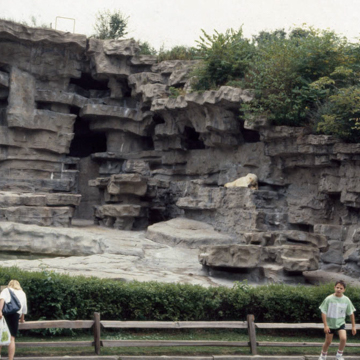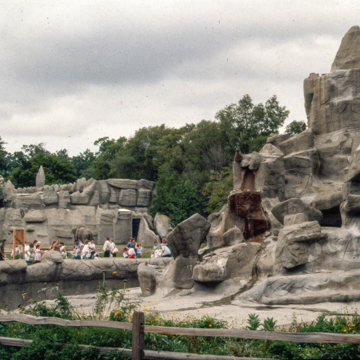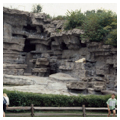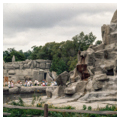The Detroit Zoological Park is a designed landscape planned by Shurtleff, a nationally known Boston landscape architect who had worked in the office of Frederick Law Olmsted. It is the only zoo in America whose exhibits were directly designed by and built under the supervision of Heinrich Hagenbeck of Hamburg, Germany, who, with his father, Carl Hagenbeck, was a world-famous zoo designer. The Detroit Zoo was the first American zoo that was entirely without bars and moated with panoramic views that included several exhibits in one scene.
Established in 1911, the Detroit Zoological Society purchased a one-hundred-acre site in Royal Oak in 1916. Shurtleff's plan is arranged with a formal central mall that is lined with animal exhibits. The mall connects the birdhouse, a domed Beaux-Arts classical building erected in 1926 to the designs of William H. Creaser of Donaldson and Meier, with the bear den. Contrasting with the symmetry of the formal mall are the free-flowing lines of the naturalistic landscape, including two lakes that follow the existing forms of the tree patterns and the topography. The Detroit plan resembles Shurtleff's plan for the Boston Zoological Park at Franklin Park and the Chicago Zoological Park. A miniature railroad, now restored as the Tauber Family Railroad, carries passengers from the main station at the entrance of the zoo to the Africa Station at the northwest corner of the park.
The Detroit Zoo was one of the first zoos in America to utilize for its animal exhibits “rockwork” enclosures made from gunite, a mixture of cement and aggregate combined with water that is sprayed at high pressure, and that simulates natural materials. By 1933 the various exhibits—wolverine and raccoon, elephant and rhinoceros, and others—were completed. Additional construction was financed in 1933–1934 under the Civil Works Administration (CWA) of the federal Emergency Relief Administration (ERA) and in 1935 under the Works Progress Administration (WPA). The chimpanzee exhibit was created in 1989 by Schervish, Vogel and Mers of Detroit, in consultation with Jon Coe, landscape architect and zoo design specialist of Philadelphia. The Arctic Ring of Life, which opened in 2001, exhibits the world's largest group of polar bears in a 4.2-acre environment similar to their natural habitat. Its 70-foot-long underwater viewing tunnel permits visitors to see the animals dive and swim.
The Horace H. Rackham Memorial Fountain was presented in 1939 to the zoo by Rackham's widow, Mary, to commemorate his role as first president of the zoological commission. Created by sculptor Corrado Joseph Parducci and designer Frederick A. Schnaple, the work consists of two ten-foot-high bronze bears playfully dancing around a central column, with frogs and turtles at their feet. All this is contained within a large reflecting pool lined with blue Pewabic tile and flanked by two subsidiary seal fountains. Together they form an arresting focal point for the zoo's central mall. The park is an extensive and well-maintained complex of winding pathways and varied buildings.







